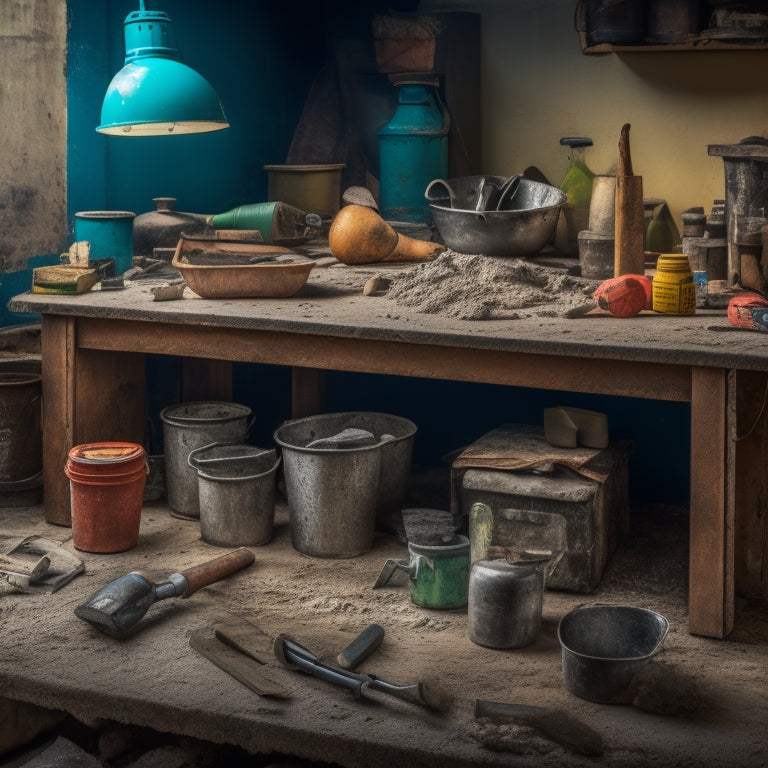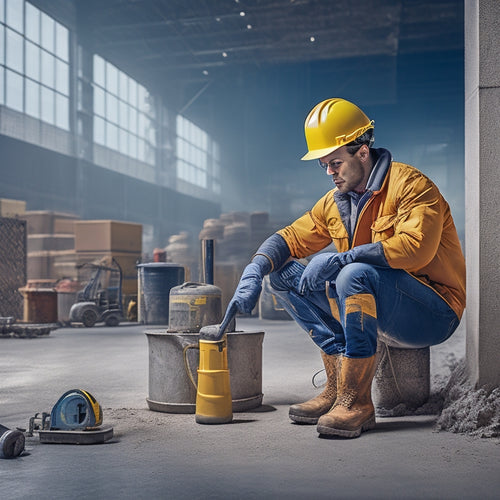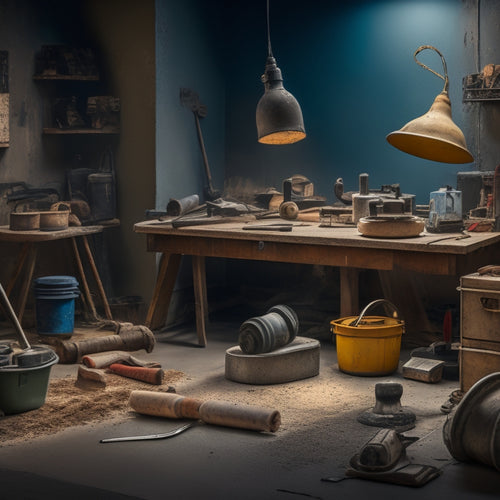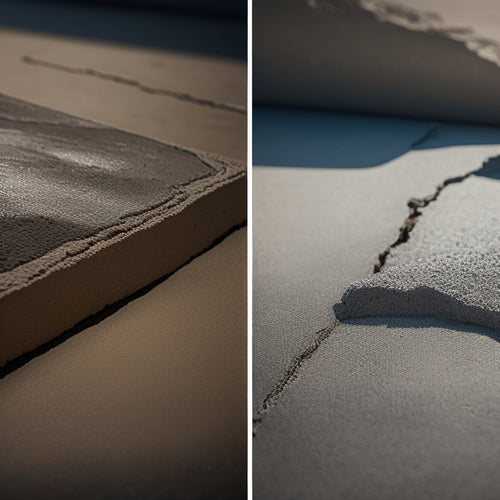
What Tools Do I Need for Concrete Repair
Share
You'll need a range of specialized tools to successfully repair and restore damaged concrete, from hammers and chisels to wire brushes and mixing equipment. A hammer and chisel set is necessary for removing damaged concrete, while a wire brush and putty knife are essential for surface cleaning and applying repair compounds. Additionally, a level, grinder, or sander with abrasives will guarantee an even surface preparation. Moreover, you'll need safety gear, including gloves, safety glasses, and a dust mask, as well as specific tools for crack filling, surface preparation, and mixing and applying repair materials, and understanding how to use them effectively will be key to a successful repair.
Key Takeaways
• Essential tools for concrete repair include a hammer and chisel set, wire brush, putty knife, level, and grinder or sander for surface preparation.
• A DIY crack filling tool kit should include a crack chaser, utility knife, putty knife, safety gear, and comprehensive assessment tools.
• Concrete surface preparation requires wire brushes, pressure washers, trowels, floats, and screeds, as well as ergonomic tools with non-slip grips.
• Mixing and application equipment includes a mixing bucket or power mixer, trowels, putty knives, and pneumatic or electric mixers for large-scale projects.
• Safety and protective gear are crucial, including protective gloves, safety goggles, respirator masks, and knee pads to ensure a safe working environment.
Essential Tools for Concrete Repair
When tackling a concrete repair project, you'll need a range of essential tools to get the job done efficiently and effectively.
From preparing the surface to applying the final coat, each step requires the right tools to guarantee a successful repair. You'll need a sturdy hammer and chisel set to remove damaged concrete and a wire brush to clean the area. A putty knife or trowel is necessary for applying repair compounds, and a level guarantees the surface is even.
To achieve a strong bond, you'll need to prepare the surface using repair techniques such as grinding or sanding. For this, you'll require a grinder or sander, along with the appropriate abrasives.
Don't forget to wear protective gear, including gloves, safety glasses, and a dust mask.
When it comes to product recommendations, look for high-quality, industry-approved materials that meet safety standards.
DIY Crack Filling Tool Kit Essentials
With a DIY crack filling project, you'll need a specialized tool kit that includes a crack chaser, a utility knife, and a putty knife to effectively clean and fill cracks in your concrete surface. These tools will help you perform a thorough crack assessment, ensuring you identify and address all cracks before proceeding with repair techniques.
Here's a breakdown of the essential tools you'll need for a DIY crack filling kit:
| Tool | Purpose | Importance |
|---|---|---|
| Crack Chaser | Removes loose debris, widens crack for filling | High |
| Utility Knife | Cuts and trims excess material | Medium |
| Putty Knife | Fills and smooths out filled cracks | High |
Remember to always follow safety guidelines when working with power tools and chemicals. Wear protective gear, including gloves, safety glasses, and a dust mask, to minimize exposure to harmful materials. By investing in these essential tools and taking necessary safety precautions, you'll be well-equipped to tackle your DIY crack filling project with confidence.
Concrete Surface Preparation Tools
You'll need to prepare the concrete surface before applying any repair materials, and that's where a set of specialized tools comes in to secure a strong bond between the old and new concrete. To achieve a clean and even surface, you'll require surface cleaning techniques, such as wire brushes, scrub brushes, and pressure washers. These tools will remove dirt, oil, and other contaminants that may interfere with the repair material's adhesion.
Additionally, you'll need to ascertain the surface is level and even. For this, surface leveling methods like trowels, floats, and screeds are essential. These tools will help you achieve a uniform surface, eliminating any unevenness or imperfections that could compromise the repair.
When selecting surface preparation tools, prioritize safety by choosing equipment with ergonomic handles, non-slip grips, and protective guards. Always wear personal protective equipment, such as gloves, safety glasses, and a dust mask, to prevent injuries and exposure to hazardous materials.
Mixing and Application Equipment
Two essential components of any concrete repair project are mixing and application equipment, which guarantee the repair material is properly blended and applied to the prepared surface.
You'll need a mixing bucket or a power mixer to combine the repair material with water and other additives, guaranteeing a consistent blend. When it comes to application methods, you'll require tools such as trowels, putty knives, and float blades to apply the repair material to the surface. The type of application equipment you need will depend on the size and complexity of the repair. For instance, you may need a pneumatic or electric mixer for large-scale projects, while a manual mixer may suffice for smaller repairs.
It's vital to master various mixing techniques, such as gradual addition of water and continuous mixing, to achieve the desired consistency. Additionally, you should be familiar with different application methods, including pouring, troweling, and spraying, to guarantee a smooth finish.
Safety and Protective Gear Needed
Every concrete repair project demands a range of safety and protective gear to shield you from hazardous materials, falling objects, and other potential dangers. You can't afford to compromise on your safety, so it's crucial to invest in the right gear.
First, you'll need protective gloves to prevent skin irritation and cuts from sharp objects. Look for gloves made from durable materials like heavy-duty rubber or synthetic fabrics.
Next, safety goggles will protect your eyes from flying debris and chemical splashes. Make sure they fit snugly and provide unobstructed vision.
A respirator mask is also a must-have when working with concrete, as it will filter out harmful dust and particles from the air.
Don't forget knee pads to cushion your knees from rough surfaces and reduce fatigue.
Frequently Asked Questions
Can I Use Regular Cement for Concrete Repair?
When it comes to concrete repair, you'll want to avoid using regular cement. It's not suitable for most repair techniques and can lead to further damage.
Instead, consider cement alternatives specifically designed for concrete repair, such as epoxy-based or polyurethane-based products. These offer better bonding, durability, and resistance to water and chemicals, ensuring a safe and long-lasting repair.
Will Concrete Repair Last as Long as New Concrete?
Imagine a strong, unyielding fortress - that's what you're aiming for with concrete repair.
But will it last as long as new concrete? The answer lies in the durability comparison.
If you employ advanced repair techniques, such as epoxy injection or polyurethane grouting, your repair can be just as strong as new concrete.
In fact, with proper execution, it can even outlast the original structure.
Can I Repair Concrete in Freezing Temperatures?
When repairing concrete in freezing temperatures, you'll need to adapt your strategy to guarantee a successful and safe outcome.
Following best practices, it's essential to wait until the temperature is above 40°F (4°C) for at least 24 hours before applying any repair materials.
Winter weather conditions can greatly impact the curing process, so you'll need to take extra precautions to protect the repair area from wind, snow, and ice.
Do I Need a Permit for Concrete Repair?
When tackling a concrete repair project, you'll need to determine if you need a permit.
Check your local permit requirements and DIY regulations to guarantee compliance.
Failing to obtain the necessary permits can lead to costly fines or even project shutdowns.
Don't risk it - research the specific regulations in your area to avoid any potential issues.
Can I Paint Over Repaired Concrete Immediately?
Did you know that 75% of concrete repairs fail due to premature painting?
Don't rush to paint over that freshly repaired concrete just yet! You need to guarantee the repair is fully cured and ready for painting.
Check the repair readiness by performing a simple water droplet test.
Once it's ready, employ proper painting techniques, such as surface preparation and primer application, to guarantee a durable and long-lasting finish.
Conclusion
As you stand victorious over a repaired concrete surface, your arsenal of tools lies scattered around you, a symbol of the battle won.
Like a master painter's brushes, each tool has played its part in creating a masterpiece of durability. The mixing bucket, once a vessel of chaos, now holds the secret to a job well done.
The trowel, a trusty sword, has smoothed out the imperfections. Your safety gear, a shield of protection, has guarded you against harm.
With these tools, you've not only repaired concrete, but crafted a work of art that will stand the test of time.
Related Posts
-

10 Best Tools for Sealed Concrete Flooring on Budget
When starting on a sealed concrete flooring project on a budget, you'll need to prioritize essential tools without sa...
-

Top Concrete Resurfacing Tools for a Pro Finish
When it comes to achieving a professional finish in concrete resurfacing projects, you require the right set of speci...
-

What Tools Ensure Strong Concrete Adhesion at Home
You'll need the right tools to guarantee strong concrete adhesion at home. For surface preparation, use concrete surf...


